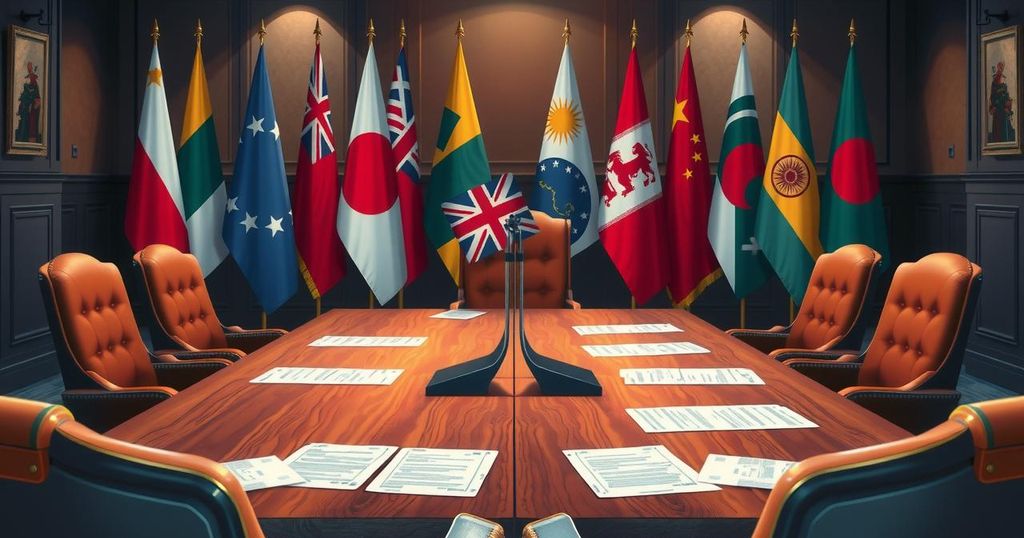Economy
Politics
AMERICA FIRST, ASIA, BRENDAN LYNCH, DONALD TRUMP, ECONOMY, EXTERNAL, EXTERNAL AFFAIRS MINISTRY, GEOPOLITICS, GOVERNMENT OF INDIA, INDIA, INTERNATIONAL RELATIONS, LYNCH, NARENDRA MODI, NATIONAL SECURITY, NEW DELHI, NORTH AMERICA, PI, TRADE, UNITED STATES, US, US ADMINISTRATION, WASHINGTON
Dante Raeburn
U.S. Trade Official’s Upcoming Visit to India Amid Tariff Concerns
Brendan Lynch, U.S. Trade Representative, will visit India from March 25-29 just before new tariffs from President Trump take effect. The visit aims to discuss a waiver of these tariffs and negotiate a bilateral trade framework. Both countries continue their engagement despite concerns regarding global trade tensions and evolving trade dynamics.
Brendan Lynch, the Assistant U.S. Trade Representative for South and Central Asia, will begin a five-day visit to India on March 25, just prior to the implementation of U.S. President Donald Trump’s reciprocal tariffs. During his visit, Lynch is expected to engage in discussions with Commerce Minister Piyush Goyal and other senior Indian officials, focusing on establishing a more favorable trade environment between the two nations.
Furthermore, Indian officials hope to negotiate a temporary waiver from these reciprocal tariffs before they officially take effect on April 2. The agenda also includes finalizing a framework for a bilateral trade agreement, primarily aimed at addressing tariffs and market accessibility issues, according to U.S. officials.
A U.S. representative highlighted that this visit underscores the United States’ dedication to fostering a constructive trade relationship with India. “We value our ongoing engagement with the Government of India on trade and investment matters and look forward to continuing these discussions in a constructive, equitable and forward-looking manner,” the official stated.
Concurrently, India has indicated that it is actively negotiating with Washington to establish this trade framework. According to Randhir Jaiswal, the spokesperson for India’s External Affairs Ministry, discussions are ongoing at various administrative levels to achieve a mutually beneficial agreement.
The tariff strategy endorsed by President Trump has raised concerns regarding the potential for a global trade war, with numerous nations indicating they will respond with their own counter-measures. After talks between Prime Minister Narendra Modi and President Trump in Washington, both countries agreed to initiate the first phase of trade agreement negotiations, projected for completion by autumn 2025.
In adherence to Trump’s “America First” policy, reciprocal tariffs have been imposed on allies that enforce higher duties on American imports. Notably, India has made significant reductions in its applied tariffs for several developed nations like Australia, the UAE, Switzerland, and Norway, under recent trade agreements, which include similar arrangements with the EU and the UK.
India has expressed willingness to lower tariffs on certain goods, including Bourbon whiskey and Electric Vehicles, as noted in its Union budget for the fiscal year 2025-26. This move is perceived as a signal to the U.S. that India is amenable to discussing tariff reductions. Additionally, the U.S. seeks to enhance imports from India, including oil, gas, and military equipment, to mitigate a current trade deficit of approximately USD 45 billion favoring India.
As of 2023, the United States ranks as India’s largest trading partner, with bilateral trade in goods and services reaching USD 190 billion. Moreover, the U.S. was recognized as the third-largest source of foreign direct investment (FDI) into India during the fiscal year 2023-24, contributing USD 4.99 billion and representing a considerable portion of total equity inflows.
In summary, Brendan Lynch’s visit to India represents a key effort by the U.S. to reinforce trade relations before the implementation of new tariffs. Discussions around a bilateral trade framework highlight both countries’ commitment to achieving mutually beneficial agreements. Concerns around the broader implications of Trump’s tariffs remain, as both nations navigate these complexities in their trade relationship.
Original Source: www.ndtv.com








Post Comment